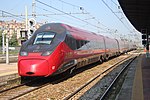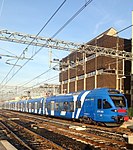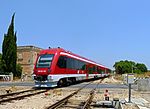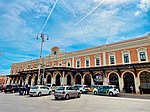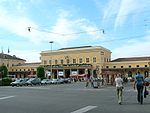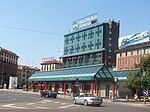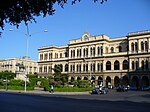Rail transport in Italy
| Italy | |
|---|---|
standard gauge | |
| Electrification | |
| 3 kV DC | conventional lines[2] |
| 25 kV AC | high-speed lines[2] |
The Italian railway system is one of the most important parts of the
The network

Lines are divided into 3 categories:
- fundamental lines (fondamentali), which have high traffic and good infrastructure quality, comprise all the main lines between major cities throughout the country. Fundamental lines are 6,131 km (3,810 mi) long;
- complementary lines (complementari), which have less traffic and are responsible for connecting medium or small regional centers. Most of these lines are single track and some are not electrified;
- node lines (di nodo), which link complementary and fundamental lines near metropolitan areas for a total 936 km (582 mi).[2]
Most of the Italian network is electrified (11,921 km (7,407 mi)). Electric system is 3 kV
A major part of the Italian rail network is managed and operated by RFI (Rete Ferroviaria Italiana, Italian Rail Network). Other regional agencies, mostly owned by public entities such as regional governments, operate on the Italian network.
Travellers who often make use of the railway during their stay in Italy might use Rail Passes, such as the European Inter-Rail or Italy's national and regional passes. These rail passes allow travellers the freedom to use regional trains during the validity period, but all high-speed and intercity trains require a 10-euro reservation fee. Regional passes, such as "Io viaggio ovunque Lombardia", offer one-day, multiple-day and monthly period of validity. There are also saver passes for adults, who travel as a group, with savings up to 20%. Foreign travellers should purchase these passes in advance, so that the passes could be delivered by post prior to the trip. When using the rail passes, the date of travel needs to be filled in before boarding the trains.[6]


Companies certified to run railways in Italy are:
- From 2000
- Ferrovie dello StatoS.p. A.
- Trenitalia S.p. A.
- From 2001
- Metronapoli S.p. A.
- Ferrovie Nord Milano Esercizio S.p. A.
- Rail Traction Company S.p. A.
- From 2002
- Del Fungo Giera Servizi Ferroviari S.p. A.
- Gruppo Torinese Trasporti S.p. A.(ex SATTI)
- SERFER Servizi Ferroviari S.r.l.
- Hupac S.p. A.
- From 2003
- Ferrovie Emilia Romagna S.r.l.
- La Ferroviaria Italiana S.p. A.
- Cargo Nord S.r.l.
- Ferrovie Adriatico Sangritana S.r.l.
- Sistemi Territoriali S.p. A.
- Strade Ferrate del Mediterraneo S.r.l.
- Swiss Rail Cargo Italy S.r.l.
- From 2004
- SBB Cargo Italia S.r.l.
- Ferrovie Nord Cargo S.r.l.
- Azienda Consorziale Trasporti di Reggio Emilia
- Ferrovia Alifana e Benevento Napoli S.r.l.
- Ferrovie Nord Milano Trasporti S.r.l.
- From 2005
- Trasporto Ferroviario Toscano S.p. A. (La Ferroviaria Italiana S.p. A.)
- Ferrovie Centrali Umbre S.r.l.
- Railion Italia S.r.l. (ex S.F.M.)
- Rail One S.p. A.
- Azienda Trasporti Collettivi e Mobilità S.p. A.
- A.T.C. Bologna S.p. A.
- Monferail S.r.l.
- From 2006
- SAD - Trasporto Locale S.p.A.
- Nord Cargo S.r.l. (ex Ferrovie Nord Cargo S.r.l.)
- Arenaways S.p.A.
History
The first line to be built on the peninsula was the
After the creation of the
The period from 1922 to 1939 was heavy with important construction and modernisation programmes for the Italian railways, which also incorporated 400 km (250 mi) from the Ferrovie Reali Sarde of

After World War II, Italy started to repair the damaged railways, and built nearly 20,000 km (12,000 mi) of new tracks. Entire lines were out of action and much of the rolling stock destroyed. Thanks to the Marshall Plan, in the following years they could be rebuilt, although the possibility of reorganizing the network was missed due to short-sighted policies.[13] The fundamental line Battipaglia-Reggio Calabria was doubled, while a program of updating of infrastructures, superstructures, services, colour-light signalling and cars was updated or extended. The three-phase lines were gradually turned into standard 3,000 V dc lines.
Increasing numbers of steam locomotives were replaced by electric or diesel ones; in the 1960s also the first unified passenger cars appeared and the first attempts of interoperability with foreign companies were started, culminating in the creation of
High-speed rail

High-speed trains were developed during the 1960s.
On 25 June 1970, work was started on the
In 1975, a program for a widespread updating of the rolling stock was launched. However, as it was decided to put more emphasis on local traffic, this caused a shifting of resources from the ongoing high-speed projects, with their subsequent slowing or, in some cases, total abandonment. Therefore, 160 E.656 electric and 35 D.345 locomotives for short-medium range traffic were acquired, together with 80 EMUs of the ALe 801/940 class, 120 ALn 668 diesel railcars. Some 1,000 much-needed passenger and 7,000 freight cars were also ordered.
In the 1990s, work started on the Treno Alta Velocità (TAV) project, which involved building a new high-speed network on the routes Milan – (Bologna–Florence–Rome–Naples) – Salerno, Turin – (Milan–Verona–Venice) – Trieste and Milan–Genoa. Most of the planned lines have already been opened, while international links with France, Switzerland, Austria and Slovenia are underway.
Most of the
Other proposed high-speed lines are Salerno-Reggio Calabria[18] (connected to Sicily with the future bridge over the Strait of Messina[19]), Palermo-Catania[20] and Naples–Bari.[21]
The main public operator of high-speed trains (alta velocità AV, formerly Eurostar Italia) is Trenitalia, part of FSI. Trains are divided into three categories: Frecciarossa ("Red arrow") trains operate at a maximum of 300 km/h (185 mph) on dedicated high-speed tracks; Frecciargento (Silver arrow) trains operate at a maximum of 250 km/h (155 mph) on both high-speed and mainline tracks; Frecciabianca (White arrow) trains operate at a maximum of 200 km/h (125 mph) on mainline tracks only.
Since 2012, a new and Italy's first private train operator, NTV (branded as Italo), run high-speed services in competition with Trenitalia. Even nowadays, Italy is the only country in Europe with a private high-speed train operator.
Construction of the Milan-Venice high-speed line has begun in 2013 and in 2016 the Milan-Treviglio section has been opened to passenger traffic; the Milan-Genoa high-speed line (Terzo Valico dei Giovi) is also under construction.
Today it is possible to travel from Rome to Milan in less than 3 hours (2h 55') with the Frecciarossa 1000, the new high-speed train. To cover this route, there's a train every 30 minutes.
Night trains

The Nightjet of the Austrian Federal Railways (ÖBB) serves different big cities in Italy like Rome, Venice, Florence and Milano. The trains can be used for rides inside Italy as well as for journeys abroad.
Nightjet trains offers beds in
Intercity trains
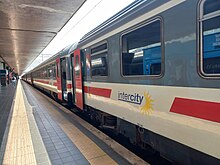
With the introduction of high-speed trains, intercity trains are limited to few services per day on mainline and regional tracks.
The daytime services (). In addition, the Intercity trains provide a more economical means of long-distance rail travel within Italy.
The night trains (Intercity Notte ICN) have sleeper compartments and washrooms, but no showers on board. Main routes are Rome to Bolzano/Bozen (calling at Florence, Bologna, Verona, Rovereto and Trento), Milan to Lecce (calling at Piacenza, Parma, Reggio Emilia, Modena, Bologna, Faenza, Forlì, Cesena, Rimini, Ancona, Pescara, Bari and Brindisi), Turin to Lecce (calling at Alessandria, Voghera, Piacenza, Parma, Bologna, Rimini, Pescara, Termoli, San Severo,Foggia, Barletta, Bisceglie, Molfetta, Bari, Monopoli, Fasano, Ostuni and Brindisi) and Reggio di Calabria to Turin (calling at Naples, Rome, Livorno, La Spezia and Genova). Most portions of these ICN services run during the night; since most services take 10 to 15 hours to complete a one-way journey, their day-time portion provide extra train connections to complement with the Intercity services.
There are a total of 86 intercity trains running within Italy per day.
Regional trains
Trenitalia operates regional services (both fast veloce RGV and stopping REG) throughout Italy.
Regional train agencies exist: their train schedules are largely connected to and shown on Trenitalia, and tickets for such train services can be purchased through Trenitalia's national network. Other regional agencies have separate ticket systems which are not mutually exchangeable with that of Trenitalia. These "regional" tickets could be purchased at local newsagents or tobacco stores instead.
- Trentino-Alto Adige/ Trentino-Südtirol: Südtirol Bahn (South Tyrol Railway) runs regional services on Ala/Ahl-am-Etsch to Bolzano/Bozen (calling at Rovereto/Rofreit, Trento/Trient and Mezzocorona/Kronmetz), Bolzano/Bozen to Merano/Meran, Bressanone/Brixen to San Candido/Innichen, and a direct "Tirol regional express REX" service between Bolzano/Bozen in Italy and Innsbruck in Austria.
- Veneto: Sistemi Territoriali runs regional trains in Veneto region.
- ÖBB on the EuroCity Verona-Munich service, and with SBB CFF FFS (joint-venture TiLo) on the regional Milan-Bellinzona service.
- Trasporto Passeggeri Emilia-Romagnaprovides vital connections across cities on different mainline networks, including Modena, Parma, Suzzara, Ferrara, Reggio Emilia and Bologna.
- Tuscany: La Ferroviaria Italiana operates in Arezzo province.
- Abruzzo: Sangritana runs daily services between Pescara and Lanciano.
In addition to these agencies, there's a great deal of other little operators, such as AMT Genova for the Genova-Casella railway.
Stations


Italy's top ten railway stations by annual passengers are:
| Rank | Railway Station | Annual entries/exits (millions) | Number of platforms | City | Region |
|---|---|---|---|---|---|
| 1 | Roma Termini |
150[22] | 32 | Rome | Lazio |
| 2 | Milano Centrale |
145[23] | 24 | Milan | Lombardy |
| 3 | Torino Porta Nuova |
70[24] | 20 | Turin | Piedmont |
| 4 | Firenze Santa Maria Novella |
59[25] | 19 | Florence | Tuscany |
| 5 | Bologna Centrale |
58[26] | 28 | Bologna | Emilia-Romagna |
| 6 | Roma Tiburtina |
51[27] | 20 | Rome | Lazio |
| 7 | Napoli Centrale |
50[28] | 25 | Naples | Campania |
| 8 | Milano Cadorna |
33.1[29] | 10 | Milan | Lombardy |
| 9 | Venezia Mestre | 31[30] | 13 | Venice | Veneto |
| 10 | Venezia Santa Lucia | 30[30] | 16 | Venice | Veneto |
Rapid transit
Metro
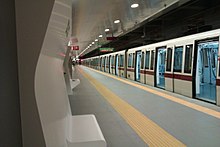
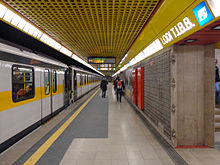
7 cities have
| City | Name | Lines | Length (km) | Stations | Opening |
|---|---|---|---|---|---|
| Brescia | Brescia Metro | 1 | 13.7 | 17 | 2013 |
| Catania | Catania Metro | 1 | 8.8 | 10 | 1999 |
| Genoa | Genoa Metro | 1 | 7.1 | 8 | 1990 |
| Milan | Milan Metro | 5 | 102.5 | 119 | 1964 |
| Naples | Naples Metro | 2 | 20.3 | 23 | 1993 |
| Rome | Rome Metro | 3 | 60 | 75 | 1955 |
| Turin | Turin Metro | 1 | 15.1 | 23 | 2006 |
Commuter rail

15 cities have commuter rail systems; cities without wikilink are those listed just above for their metro rail system.
- Bari (Bari metropolitan railway service, 3 lines)
- Bologna (Bologna metropolitan railway service, 8 lines)
- Cagliari, 1 line
- Catanzaro, 2 lines
- Genoa (Genoa urban railway service, 3 lines)
- Messina, 1 line
- Milan (Milan suburban railway service, 12 lines)
- Naples, 8 lines
- Palermo (Palermo metropolitan railway service, 2 lines)
- Perugia, 1 line
- Potenza, 1 line
- Reggio Calabria, 1 line
- Rome (FL lines, 8 lines)
- Salerno (Salerno metropolitan railway service, 1 line)
- Turin (Turin metropolitan railway service, 8 lines)
Airport shuttles


Airport shuttle buses are highly developed and convenient for rail travellers. Most airports in Italy are not connected to the railway network, except for
of the Milan metro since 2022.- Venice: Venezia-Mestre station - Marco Polo Airport (50 minutes) and Treviso Airport
- Milan: Milano Centrale station - Malpensa Airport (1 hour 5 minutes), Linate Airport (35 minutes) and Milan Bergamo Airport (1 hour)
- Brescia: Brescia station - Milan Bergamo Airport (1 hour)
- Rome: Rome Termini station - Fiumicino Airport (31 minutes)
- Verona: Verona Porta Nuova station - Villafranca "Catullo" Airport (20 minutes)
- Bologna: Centrale station - Bologna Airport (20 minutes) - Route modified in November 2020. It shifted from route BLQ (Bologna Centrale Station-Bologna Airport) to route 944 Ospedale Maggiore-Bologna Airport
- Pescara Centrale station - Abruzzo Airport (10 minutes)
- Pisa: Pisa Centrale station - San Giusto Airport (5 minutes)
- Florence: Firenze S M Novella station - Florence Airport
Rail links to adjacent countries
Italy has 11 rail border crossings over the Alpine mountains with her neighbouring countries: six are designated as mainline tracks and two are metre-gauge tracks. The six mainline border crossings are: two with France (one for Nice and Marseille; the other for Lyon and Dijon), two with Switzerland (one for Brig, Bern and Geneva; the other for Chiasso, Lugano, Lucerne and Zürich), and two with Austria (one for Innsbruck; the other for Villach, Graz and Vienna). The two-metre-gauge track crossings are located at the border town of Tirano (enters Switzerland's Canton Graubünden/Grisons) and Domodossola (enters Switzerland's Locarno).
There is a railway line connecting Italy's northeastern port of Trieste to Slovenia, but no passenger or freight services operate on this track. Consequently, there is no direct connections between Trieste and Ljubljana, the capital of Slovenia, despite the proximity of both cities.
- Italy-France: Moscow-Nice.
- Italy-France: ThelloVenice-Paris
- Italy-Switzerland: Domodossola–Locarno railwaymetre-gauge trains
- Italy-Switzerland: Simplon Tunnel, currently EuroCity trains of SBB CFF FFS Milan-Geneva and Milan-Bern
- Italy-Switzerland: connecting Varese (Italy) to Bellinzona (Switzerland) and runs on the eastern coast of Lake Maggiore
- Italy-Switzerland: Milan–Chiasso railway, currently EuroCity trains of SBB CFF FFS Milan-Zürich
- Italy-Switzerland: Bernina railway at 2,253 m (7,392 ft) above sea, metre-gauge trains of RhBTirano-St. Moritz and the Bernina Express tourist train
- Italy-Austria: ÖBB-DB Munich-Verona and Munich-Venice/Bologna, and DB CityNightLineMunich-Rome/Milan
- Italy-Austria: at 1,175 m (3,855 ft) above sea connecting San Candido/Innichen (Italy) and Lienz (Austria)
- Italy-Austria: connecting Venice and Udine (Italy) to Villach (Austria), currently EuroCity trains of ÖBB Vienna-Rome/Milan, and DB CityNightLineMunich-Venice
- Italy-Slovenia: Tarvisio–Ljubljana Railway
The
All links have the same gauge.
 Austria — voltage change 3 kV DC/15 kV AC
Austria — voltage change 3 kV DC/15 kV AC France — voltage change 3 kV DC/25 kV AC or 1.5 kV DC
France — voltage change 3 kV DC/25 kV AC or 1.5 kV DC- Slovenia— same voltage
 Switzerland — voltage change 3 kV DC/15 kV AC (plus two narrow gauge lines, same voltage)
Switzerland — voltage change 3 kV DC/15 kV AC (plus two narrow gauge lines, same voltage)- Vatican City— no electrification
- San Marino— closed, narrow gauge

Stations on the border are:
- Rome-Vatican Cityrailway
- Ventimiglia is the border station on the Genoa-Nice main line.
- Olivetta San Michele and Limone Piemonte on both sides of the Tenda Railway
- line).
- Domodossola is the border station of the Milan-Bern/Geneva main line (Simplon Tunnel line).
- Ribellasca is on the Vigezzina.
- Oleggio–Pino railway.
- Gotthard Tunnelline).
- Rhätische Bahn.
- Brenner railway).
- San Candido is the border station of the Fortezza-Lienz secondary line.
- Wien main line (Austrian Southern Railwayline).
- Gorizia Centrale station serves as link to the Slovenian Railways, through the station of Nova Gorica, which can be entered also directly by pedestrians from the Italian side.
- Villa Opicina, Trieste) serves as link to the Slovenian Railways, through the stations of Sežana and Repentabor.
Heritage railways
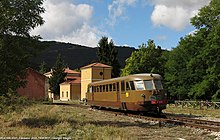
In Italy the
The list is periodically updated by decree of the Ministry of Infrastructure and Transport, in agreement with the Ministry of Economy and Finance and the Ministry of Culture, also taking into account the reports in the State-Regions Conference, a list which in 2022 reached 26 railway lines.[34] According to article 1, law 128/2017 has as its purpose: "the protection and valorisation of railway sections of particular cultural, landscape and tourist value, which include railway routes, stations and related works of art and appurtenances, and of the historic and tourist rolling stock authorized to travel along them, as well as the regulation of the use of ferrocycles".[33]


Below is the list of railway lines recognized as tourist railways by Italian legislation.
- Sulmona-Castel di Sangro section of the Sulmona–Isernia railway[35]
- Cosenza-Camigliatello–San Giovanni in Fiore railway[36]
- Avellino–Rocchetta Sant'Antonio railway[35]
- Gemona del Friuli–Sacile railway[35]
- Palazzolo–Paratico railway[35]
- Castel di Sangro-Carpinone section of the Sulmona-Isernia railway[37]
- Ceva–Ormea railway[35]
- Mandas–Arbatax railway[38]
- Isili–Sorgono railway[38]
- Sassari–Tempio-Palau railway[38]
- Macomer–Bosa railway[38]
- Alcantara–Randazzo railway[35]
- Castelvetrano-Porto Palo section of the Castelvetrano–Porto Empedocle railway[39]
- Agrigento Bassa-Porto Empedocle section of the Castelvetrano-Porto Empedocle railway[39]
- Noto–Pachino railway[35]
- Asciano–Monte Antico railway[35]
- Civitavecchia–Orte railway[35]
- Fano–Urbino railway[35]
|
b) pursuant to the Ministerial Decree of 30 March 2022:[34]
|

The
In July 2023,
- Luxury trains, which includes the circulation of the "Venice Simplon Orient Express, already operating on European routes;[41]
- Express and historic trains, with the express trains of the 1980s and 1990s which being redeveloped and modernized in the railway workshops of Rimini, while the historic trains are used for journeys that include stops with guided tours and tastings;[41]
- Regional trains, also with trips that include experiential tourist stops, which pass through places rich in history, with villages and areas of landscape, naturalistic, food and wine and agri-food interest.[41]
Funding
The Italian railways are partially funded by the government, receiving €8.1 billion in 2009.[42]
Categories and types of trains
These are the major service categories and models of Italian trains.
-
Italo operates on main High-Speed lines by NTV. Makes a few stops in the most important cities.
-
Frecciarossa operates on High-Speed lines by Trenitalia. Makes a few stops in major cities.
-
Frecciargento operates on High-Speed lines by Trenitalia. Makes some stops in big cities.
-
Frecciabianca operates on main lines by Trenitalia. Stops in big cities.
-
Intercity operates on main lines by Trenitalia. Stops in big cities.
-
Eurocity, formerly Cisalpino, operates on international main lines within the European Union by Trenitalia. Stops in big cities.
-
RegionaleVeloce operates on regional lines in a region or in adjacent regions by Trenitalia. Stops in the main stations of the local service.
-
Regionale operates on regional lines by Trenitalia. Stops in every station of the local service.
-
Regio-Express operates on regional lines by Trenord. Stops in some station of the local service.
-
RegionaleVeloce as operates in the Aosta Valley by Trenitalia
-
RegionaleVeloce as operates in Veneto by Trenitalia
-
Regionale as operates inTrentino-Alto Adigeby SAD
-
Regionale as operates in some lines of Veneto by Sistemi Territoriali (ST)
-
Regionale as operates in Friuli-Venezia Giulia by Società Ferrovie Udine-Cividale (FUC)
-
Regionale as operates in Apulia by Ferrovie del Sud Est (FSE)
Main stations
-
Milano Centrale, Milan
See also
- Ferrovie dello Stato Italiane
- History of rail transport in Italy
- Railway stations in Italy
- Transport in Italy
- Trenitalia
- Treno Alta Velocità
- Rail transport in Europe
References
- ^ "Railway passenger transport statistics" (PDF). Europa EU. 8 December 2019. Retrieved 9 January 2021.
- ^ a b c d e f g h "La rete oggi". RFI Rete Ferroviaria Italiana. Archived from the original on 4 December 2011. Retrieved 15 November 2011.
- ^ Total length of tracks: double tracks are counted twice.
- ^ Compare List of countries by rail transport network size.
- ^ "Il sistema di elettrificazione a 25kV c.a." RFI Rete Ferroviaria Italiana. Retrieved 16 November 2011.
- ^ "Rail Passes - ItaliaRail - Italy Train Ticket and Rail Pass Experts". italiarail.com.
- ^ "La Dolce Vita? Italy By Rail, 1839-1914 | History Today". History Today. Retrieved 29 December 2019.
- ^ "Le ferrovie nell'Unità d'Italia. Cronologia storica 1839-1861". Fondazione FS. Retrieved 3 October 2023.
- ^ "Prospetto cronologico dei tratti di ferrovia aperti all'esercizio dal 1839 al 31 dicembre 1926". Ufficio Centrale di Statistica delle Ferrovie dello Stato. 1927. Retrieved 11 May 2023.
- ^ Gian Guido Turchi (2006). Strade Ferrate Meridionali: ultimo atto (in Italian). Edizioni ETR. pp. 13–14.
- ^ Cesare Columba, Da Firenze a Bologna bucando l'Appennino in, VdR 1839-1939: i centocinquant'anni delle ferrovie italiane, pp. 26-28
- ISBN 88-85068-23-5
- ^ Paolo Lavadas; Mauro Luoni (2011). 1861-2011, 150°, L'unità d'Italia attraverso le ferrovie (in Italian). Editoriale del Garda. p. 21.
- ^ "Ferrovie dello Stato" (in Italian). Retrieved 20 August 2008.
- ^ "Frecciarossa 1000 in Figures". Ferrovie dello Stato Italiane. Archived from the original on 18 December 2014. Retrieved 24 November 2014.
- ^ "Special report: A European high-speed rail network". op.europa.eu. Retrieved 22 July 2023.
- ^ "Viaggia con i treni Frecciarossa e acquista il biglietti a prezzi scontati - Le Frecce - Trenitalia". trenitalia.com (in Italian). Retrieved 14 May 2017.
- ^ "Ferrovie: Ecco il progetto della AV/AC Salerno-Reggio Calabria" (in Italian). Retrieved 8 February 2021.
- ^ "Alta velocità ferroviaria SA-RC, come cambiano gli scenari" (in Italian). Retrieved 21 February 2024.
- ^ "Alta velocità ferroviaria Salerno-Reggio e Palermo-Catania Messina: aggiudicati lavori per altri 3,7 miliardi" (in Italian). Retrieved 21 February 2024.
- ^ "Alta velocità Napoli-Bari. Partiti i lavori. Sei miliardi per collegare le due città in 2 ore a 40 minuti" (in Italian). Retrieved 21 February 2024.
- ^ "Roma Termini - Roma Termini - Grandi Stazioni". Archived from the original on 11 November 2014. Retrieved 12 November 2022.
- ^ "Stazione di Milano Centrale - Info Stazione Milano Centrale - Tour Virtuale stazione | Milano Centrale". www.milanocentrale.it (in Italian). Archived from the original on 27 November 2019. Retrieved 29 April 2019.
- ^ "Torino Porta Nuova - Torino Porta Nuova - Grandi Stazioni". Archived from the original on 15 June 2011. Retrieved 12 November 2022.
- ^ "Firenze S. Maria Novella - Firenze S. Maria Novella - Grandi Stazioni".
- ^ "Bologna Centrale - Bologna Centrale - Grandi Stazioni". Archived from the original on 10 February 2012. Retrieved 12 November 2022.
- ^ "Roma Tiburtina - Roma Tiburtina - Grandi Stazioni". Archived from the original on 17 March 2015. Retrieved 12 November 2022.
- ^ "Napoli Centrale - Napoli Centrale - Grandi Stazioni". Archived from the original on 8 August 2017. Retrieved 13 January 2017.
- ^ Bilancio Sociale "LeNord" 2004-2005
- ^ a b "Venezia Mestre - Venezia Mestre - Grandi Stazioni". Archived from the original on 8 September 2018. Retrieved 12 November 2022.
- ^ "La Ferrovia dello Stato della Città del Vaticano" (in Italian). Sala stampa della Santa Sede. Retrieved 9 January 2012.
- ^ "la "Ferrovia Rimini - San Marino"" (in Italian). ferroviedismesse.com. Archived from the original on 24 February 2020. Retrieved 6 January 2012.
- ^ a b c d Gazzetta Ufficiale della Repubblica Italiana. "Legge 9 agosto 2017, n. 128".
- ^ a b "Tratte ferroviarie ad uso turistico" (PDF) (in Italian). Retrieved 24 February 2024.
- ^ a b c d e f g h i j k l m n o p q r A ordinary gauge, owned by RFI.
- narrow gauge, regional railway owned by Calabria railways; the service is called Trenino della Sila].
- ^ Subsequently extended to Isernia.
- ^ narrow gauge, regional railway owned by ARST; the service is called Trenino Verde.
- ^ a b Line part of the disused narrow gauge FS network of Sicily.
- ^ A ordinary gauge, regional railway owned by Ferrovienord.
- ^ a b c d "Gruppo FS, nasce la nuova società "FS Treni Turistici Italiani"" (in Italian). Retrieved 24 February 2024.
- ^ "The age of the train" (PDF). Archived from the original (PDF) on 17 November 2015. Retrieved 14 November 2015.
Bibliography
- ISBN 9781846557743.
- Fascicolo Linea 82 bis – AV/AC Torino – Milano – Napoli Tratto di linea Milano Rogoredo – Firenze Castello e relative interconnessioni con linea Milano – Bologna – Firenze (Tradizionale) (in Italian). Rete Ferroviaria Italiana. pp. 90–119 and 150–179.
External links
- RFI (Infrastructure manager) Official website (Italian only)
- Lyon Turin Ferroviaire
- Railway Technology.com article on Italian High Speed Rail, including NTV, Accessed 5 February 2008
- Italian HS System



